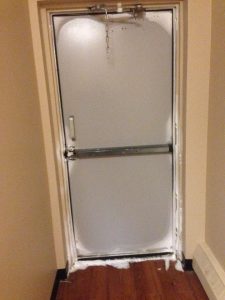Written by: Chris Taylor, Practice Lead, OHS & Indoor Hygiene at Pinchin Ltd.
From January to March of this year, I had the privilege of providing a week of training services in five communities within Nunavut. The 5 training sessions were focused on General Safety, Working at Heights, Confined Spaces and Mould Remediation and was designed around local workers being able to conduct a broader level of services for their clients.
Pinchin has a very long history of providing northern-focused training (Pinchin West had an office in Yellowknife for nearly 10 years) and because of these recent training projects, Pinchin is under consideration to develop for the Workers Safety and Compensation Commission of the Northwest Territories and Nunavut, northern based training courses in Asbestos and Working at Heights.
The issues faced by the maintenance staff are somewhat unique and extreme compared to similar organizations in the south. Temperatures over the three month period of training routinely hovered in the -60 C range (after wind chill). One of the common maintenance issues relates to sanitary exhausts being plugged by ice; maintenance staff have to go onto the (metal) roofs to knock the ice free so as to prevent the home from building up sewer gases. While several of the communities have telelift units to get them safely to the work zone, these cannot always be used and so plans had to be developed that allow for safe access using more traditional fall protection systems.


In regard to internal maintenance, again there are numerous challenges. Most of the homes in Nunavut are over-occupied (8-10 people in a 4 person home is not unusual) and flex homes (homes where occupants could be moved during mould removal, for example) are not always available. In regard to mould, even basic design elements in the home support mould growth; an example of this is that most homes use radiant heating as opposed to forced air, kitchen stove exhausts rarely vent to the outside, and often bathroom vents either do not exist or have been disconnected by the occupants due to noise issues. Combined with the high occupant loading, mould is a very common issue. Those who work in the mould industry know that all of the major guidelines indicate that once wet, the goal is to address within 48-72 hours; in many cases in the north, work is tabled until the summer season.
Additionally, there are the basic challenges of isolated communities in the north. Non-perishable goods typically arrive during the sea lift which occurs in late August/early September – however orders for these goods must be submitted as early as the end of March. None of these communities are road-serviced, therefore if you want something “in a hurry” it can take 2-3 days and must be air shipped at a much greater expense.
I am thankful for having the opportunity to provide this type of training to the Nunavut; there is certainly no lack of work in this region, but the isolation of these communities means that many workers have been doing work that would be considered very unsafe in the south – simply due to a lack of available training.
I urge anyone who has an opportunity to visit the north to do so – but maybe try August…oh, and if you are ever in Cambridge Bay I can highly recommend the Muskox Burger at the Saxifrage Café (also Rick Mercer approved).
If you are looking for assistance with worker training programs in northern regions of Canada, please feel free to reach out to me or visit www.pinchin.com for more information about all the training Pinchin offers across Canada.